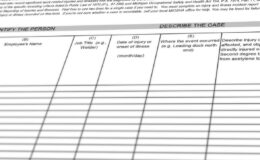By Donna Motley, Vice President of Claims
Seems like – what used to be simple, is not so simple anymore! Procedures are established for a reason – to simplify things!
In an ideal world, when an employee is injured at work, the injury is reported to the Supervisor, Safety Representative and/or Human Resource personnel. A claim is filed on the appropriate forms with your Workers’ Compensation carrier (MTMIC !). The employee is sent to the Occupational Clinic where treatment is rendered; the injured worker may be referred to a specialist. The injured worker will treat until the injury is resolved, then discharged from care, and the employee is released back to work. The steps seem pretty cut and dry and while medical care is not considered “cheap” by any means, Michigan Workers’ Compensation includes a fee sched-ule resulting in 40-60% savings on most medical bills. As an employer, I’m sure you are astounded at times, when you see the dollar amount spent on some work related injuries.
There are “hidden” costs. When I say “hidden” I mean there are costs associated not related to actual medi-cal “treatment”. When injured workers take it upon themselves to treat with their primary care physician, our office has to then request the primary care physician medical records. Approximately 50% of the time, the primary care physician will charge a fee for the records. (As a side note – this also delays treatment for the injured worker.) When an injured worker sustains an injury or an aggravation to a body part for which they sought treatment in the past, our office has to request the medical records covering the past treatment. Again, there is usually a charge for the past records. When past treatment involves a hospital, there is always a charge for medical records.
If the injured worker does not speak English and there is no family member to interpret for them, we have to hire a translator.
Per the Workers’ Compensation Act, injured workers are compensated for mileage to and from medical appoint-ments. If the injured worker does not have a driver’s license, does not have a vehicle, or does not have some-one to transport them to the medical appointments, we pay for transportation through a service company.
When a motor vehicle accident occurs in the course of employment and a claim is filed with the auto carrier, the auto carrier will pay bills and services without question and then subrogate against the Workers’ Compensation carrier. If the injured worker and/or their auto car-rier file a lawsuit against the other vehicle involved in the accident, the Workers’ Compensation carrier is entitled to file a lien against monies paid to the injured worker. However, typically if we are able to collect, it is usually only cents on the dollar; and if settlement is made to the injured worker to compensation for “pain and suffering”, Workers’ Compensation recoups nothing as Workers’ Compensation does not pay for, or cover, “pain and suf-fering”.
In serious injuries where the injured worker cannot care for themselves at home (i.e., they live alone, they don’t want attendant care in their home, they cannot ambulate steps, etc.), Worker’ Compensation would have to send the injured worker to an in-patient Rehabilitation facility until they are discharged and able to care for themselves in their own home.
If an employer is not able to accommodate light duty restrictions placed on the injured worker by the treating physician, Workers’ Compensation has the authority to place the injured worker in “transitional work”. Tran-sitional work can be minimum wage employment or an assignment with a charity. Workers’ Compensation continues paying the wage loss benefits to the injured worker and a fee is charged by the company finding and arranging the restricted or light duty work.
And finally, in cases where the injured worker has insurance coverage through Medicaid or Medicare, and medical bills for treatment have been processed through Medicaid or Medicare, by law, Workers’ Compensation has to reimburse said entities at 100%.
It is a positive for the injured worker that these accommodations can be accomplished, but the price of same is over and above the actual medical treatment of the injury. As we age, it seems everything gets more compli-cated!





